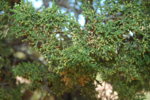Vance, I have only recently (in the past 6 years) had the opportunity to learn much about our native junipers. I’ll share some of my discoveries.
All of the Sierra Junipers I have seen in pots have blue foliage. So naturally, I assumed they had blue foliage. Until... I went into the Sierra mountains, to view the view the wild trees growing at 10,000 feet, where they are native. Guess what? They’re green! If I hadn’t been with people who could positively have told me they were the same species as in the bonsai garden, I would never have believed they were the same!
So, why are Sierra Junipers green when growing wild in the mountains, and blue in the gardens?
I don’t know. Some factors that may come into play: elevation, water quality, humidity, frequency of water, soil pH, water pH, different UV exposure between mountain environment and the lower elevations, fertization, soil composition, soil temperature, daytime temperatures, nighttime temperatures, difference between day and night temperatures, length of cold and/or hot seasons...
I’m sure there’s more factors that may play a part in just the color!
Not to mention the growth habits are a bit different before and after collection, too! A tree that has tight foliage up on the mountain might change to loose and straggly once collected. It may be totally free of fungus on the mountain but very easily infected in our garden.
So...
I have come to the conclusion that while it may seem that we are “ruining” mother nature’s creation by changing the foliage from native to something we like better, like Kishu, it’s actually the best thing we can do. We have taken the tree out of its native environment, where it thrives, to an environment where it struggles to be healthy. It’s better for the tree (at least for the trunk!) to graft on foliage that thrives in its new environment, and actually looks like it’s native foliage in its native environment.
So, for instance, a California juniper would die in a couple years if left with California foliage inmy climate in Georgia. It’s very humid and rainy here. California juniper lives in a very hot, dry climate in California. They seldom live more than 3 years here. With grafted on Kishu foliage, they do far better! And with grafted kishu roots, well, they do just as well as a 100% Kishu tree.
I know some believe that changing the foliage is a sacrilege. That we are defiling the tree. I view it differently. That since we have removed the tree from the environment it has evolved to live in, changing the foliage is giving the tree a life support system so it can adapt to its new environment.










